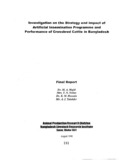Investigation on the strategy and impact of artificial insemination programme and performance of Crossbred Cattle in Bangladesh
Citation
Majid, M. A., Nahar, T. N., Hossain, K. M., & Talukder, A. I. (1998, August). Investigation on the strategy and impact of artificial insemination programme and performance of Crossbred Cattle in Bangladesh. Research Reports (1998): Social Studies, Vol – XVIII, 181–233.Abstract
This collaborative study was -sponsored by BRAC and executed by the Bangladesh
Livestock Research Institute (BLRI), Savar with logistic and other support of the
Department ofUvestock Services (DLS), GOB to investigate the strategy and effectiveness
of the artificial insemination (AI) programme of the DLS and BRAC at different AI
centres, sub-centres and points and to evaluate the performance of the crossbred cattle in
Bangladesh. Four district AI centres, 12 AI sub-centres, 16 AI points under DLS and 7 AI
points under BRAC were selected. Three villages with varying distance from Al centres or
sub-centres of each district and two villages under each Al point were selected. Twelve
households rearing crossbred cattle from each village were selected to study the
performance of crossbred cattle while 25 households were selected from each village to
determine their socioeconomic status and the impact of Al.
Findings show the Al bulls supplied to district AI centres did not strictly conform to the
national breeding policy. The semen evaluation system was satisfactory at the central AI
laboratory but were not so at different district AI laboratories. Semen preservation systems
and facilities were also not very scientific. Almost 50% of the study areas were supplied
with liquid semen in vials and the supply was often irregular. The mode of transportation
was also traditional which included bus, rickshaw, bicycle or even walking. Most of the AI
sub-centres could not examine semen due to absence of equipment and facilities such as
microscope, electricity or due to some social problem. Milk yields of crossbred cattle varied
and was found higher during the rainy season in Jessore, Rangpur and Comilla but were
lower in flood prone areas in Tangail. The best performance was found among Local x
Friesian cows followed by Local x Sindhi and L x J. The reproductive performances of
Friesian cross progenies were found better than others.
Data showed that BRAC cattle rearers had smaller cultivated land, higher level of
education, higher involvement of women in livestock rearing and greater awareness about
AI services than non-BRAC rearers. Almost 100% of BRAC rearers used AI to cross their
cattle. They also took better care of their animals and achieved higher conception rate.

